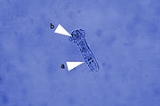
Dactylogyrus
Encyclopedia
Dactylogyrus is a genus of the Dactylogyridae family. They are commonly known as gill flukes
Like other monogeneans, Dactylogyrus only has one host required to complete its life cycle.
After the eggs hatch, water currents aid the free-swimming ciliated larva in reaching its host. The time required for egg maturation into the adult form is temperature dependent. Water temperatures of 72–75°F allow life cycle completion in a few days, whereas temperatures of 34–36°F extend the generation time to five or six months.
It is also generally accepted that fish are exposed to increased Dactylogyrus infections during their spawning period.
In severe infections, Dactylogyrus can cause hemorrhaging and metaplasia of the gills which can lead to secondary bacterial infections and death. Heavily infected fish are also anorexic and can be found gasping for air and exhibiting abnormal behavior such as jumping out of the water.
Like other monogeneans, Dactylogyrus only has one host required to complete its life cycle.
Introduction
Dactylogyrus (common name: Gill Fluke) are oviparous monogeneans that have two pairs of anchors. These anchors can be used to latch onto the gills of a host, particularly freshwater fish such as carp. In heavily infected fish, Dactylogyrus can also be found on the buccal cavity. Other characteristics of the Dactylogyrus include the appearance of four eye-spots, 14 marginal hooks, one to two connective bars and two needle-like structures and spindle-shaped dactylogyrid-type seminal vesicles.Life cycle
The Dactylogyrus life cycle is direct, having no intermediate host. The hermaphroditic adults are oviparous and produce eggs into the water which hatch prior to attaching to the gills of a fish host and developing into an onchomiricidium.After the eggs hatch, water currents aid the free-swimming ciliated larva in reaching its host. The time required for egg maturation into the adult form is temperature dependent. Water temperatures of 72–75°F allow life cycle completion in a few days, whereas temperatures of 34–36°F extend the generation time to five or six months.
Prevalence
Dactylogyrus is a monogean parasite that is usually found on the gills of Cyprinidae fishes. The prevalence of Dactylogyrus infection on fish differ depending on the seasons. It was found that Dactylogyrus infections are at their greatest during late autumn or early winter. Correlation has also been found between the temperature of the water and the intensity of Dactylogyrus infection.It is also generally accepted that fish are exposed to increased Dactylogyrus infections during their spawning period.
Symptoms
Cyprinidae that are infected by Dactylogyrus may have symptoms that include inflamed gills, excessive mucous secretions and accelerated respiration. The infected fish also becomes lethargic, swims near the surface, and its appetite decreases. Additionally the infected fish may hold its gill covers open and scratch its gills on rocks.In severe infections, Dactylogyrus can cause hemorrhaging and metaplasia of the gills which can lead to secondary bacterial infections and death. Heavily infected fish are also anorexic and can be found gasping for air and exhibiting abnormal behavior such as jumping out of the water.

